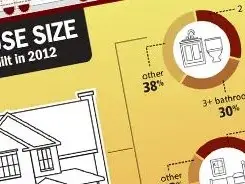According to the Environmental Protection Agency, Americans spend about 90% of their time indoors.
Making a few upgrades to your house, especially if it’s an older home, can create a healthier, cleaner living space that improves your home's air quality, replaces toxic building materials, and fights airborne pollutants.
Improve Your Indoor Air Quality (IAQ)
The air you breathe in your home should be the cleanest, but that’s not always the case. Some of the more common airborne pollutants found in most homes include:
- Mold;
- Dust/dander;
- Carbon Monoxide;
- Asbestos;
- Radon;
- Environmental tobacco smoke.
Depending on your amount of exposure and any pre-existing medical conditions you have, you may experience the health effects of exposure to these airborne pollutants either immediately or years later. Immediate effects include irritation of the eyes, nose, throat, dizziness, and nausea; delayed effects include respiratory disease, heart disease, and even cancer.
To improve your IAQ, consider installing an air purifier. They sanitize your home's air by removing harmful particles that cause illness. Humidifiers and dehumidifiers can also help improve your home's IAQ.
Check Your Water Filters
The quality of your home's tap water can also affect your health. If you're using a water filter on any household faucet to remove harmful contaminants that may pass through your tap water, be sure to test your filter with a proper test kit at consistent intervals to make sure it's working.
Some harmful contaminants found in tap water include:
- Nitrogen;
- Bacterial toxins;
- Metals;
- Pesticides.
- Ensuring your water filter is working properly stops these chemicals from reaching your bloodstream and causing salmonella, hepatitis, and other harmful illnesses.
Low/No VOC Paint
You may enjoy a nice household painting project, but certain household paints may contain volatile organic compounds (VOCs), like Benzene, known to cause short-term and long-term illness.
Short-term health effects of breathing in VOCs include dizziness, irritation of the eyes and nose, and headaches; long-term health effects include nervous system and organ damage.
Switching to a low-VOC or VOC-free paint greatly reduces your risk of obtaining VOC-induced illness. Paints with no VOCs are considered a far safer alternative even compared to low-VOC paints, so the more you can stay away from volatile organic compounds, the safer your home will be.
While repainting can certainly be a DIY project, if the idea doesn't excite you, consider hiring a professional instead.
Blackout Curtains
A good night's rest is invaluable to your health, known to improve memory, concentration, and your ability to learn. But many today are finding it more difficult to fall asleep at night because of smartphones, excessive caffeine intake, and too much light in our bedrooms.
Installing blackout curtains prevents light from entering your bedroom. Your sleep cycle is greatly influenced by melatonin secretion, and keeping as much light out of your bedroom as possible is imperative to good physical health and a better sleep cycle.
Change Your Lighting
The French Agency for Food, Environmental and Occupational Health & Safety recently warned that long-term exposure to LED lights commonly found in most households can potentially damage your retinas. These are called "phototoxic effects" and high-intensity blue light is a popular source, even causing age-related macular degeneration after long-term exposure.
Switching to lighting that's easier on the eyes and contains less blue light will improve your circadian rhythm, greatly reduce your risk of retina damage, and reduce exposure to phototoxic effects. Allowing more natural daylight into your home throughout the day is another great way of creating a healthier living space at home.
If you're not well-versed in the electrical work that goes into replacing lighting, consider hiring a professional to switch out your home's lighting instead.
Consider Smart Home Technology
Smart home technology can passively monitor the quality of your home's living space and report on any potential health hazards that may be present, monitoring lighting exposure, air quality, and supporting other health-monitoring devices you may use throughout the day.
Smart home technology can also contribute to the development of healthier daily habits by providing you with regular reminders and an optimal home environment. Thoroughly research smart home technology and contact a professional with your questions should you consider this option.
Non-Toxic Building Materials
We touched on volatile organic compounds earlier, but VOCs aren't the only toxins you'll find in your home's building materials. Other common toxins found in most homes include:
- Formaldehyde, a chemical commonly used in pesticides;
- Benzyl benzoate, a common insecticide and food additive;
- Lead, known to cause brain damage and is abundantly found in many building materials;
- Parabens, pharmaceutical preservatives.
You'll commonly find these chemicals and other health hazards in homes constructed in the early to mid-20th Century. Upgrading to greener home building materials, like stone, cork, bamboo, cob, and cordwood, greatly reduces the health risks associated with simply being in your home.
Hire a professional to replace your building materials if you're considering upgrading to a more eco-friendly living space.
Remodeling
Sometimes a simple remodel is all it takes to reduce the number of health hazards found in your home. Remodeling a space in your home allows you to upgrade its building materials, upgrade its lighting, and remove or replace any physical hazards that may present themselves to guests, like an older floor or a not-so-obvious step.
Kitchen
Remodeling your kitchen can remove compound floor contamination from spillages and other kitchen accidents, replace old and rickety cabinets that may pose harm to little hands, and replace any old electrical wiring that may pose fire hazards. Your home's kitchen should be an enjoyably safe place to congregate, so taking the time to remodel will contribute to a healthier living space.
Create a Fitness Space
If you struggle with getting yourself to the gym, creating your own at-home fitness space will help you stay on top of your physical health and provide privacy when you workout. You can set up your own fitness space yourself or hire a professional to design and implement a private fitness space for you.
 Click to call
Click to call




